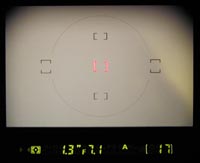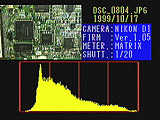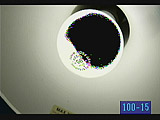Digital Camera Home > Digital Camera Reviews > Nikon Digital Cameras > Nikon D1
Nikon D1
The D1 WonderCam!
<<Design :(Previous) | (Next): Optics>>
Page 4:Viewfinder
Review First Posted: May 12, 2000
|
Viewfinder

The D1 is equipped with an optical viewfinder
that works through the lens (the LCD monitor is for image playback only). The
circular optical viewfinder features a diopter adjustment dial and a sliding
protective shutter that is manually moved in and out of place by a small lever.
Nikon states that the optical viewfinder provides about 96 percent frame
coverage, which agrees well with our own measurements. An illuminated display
inside the viewfinder provides an information readout that includes focus
indicators, shutter speed, aperture, exposure mode, metering, shutter-speed
lock, aperture lock, AE lock, electronic analog display, frame counter, ready
light and five sets of focus brackets. (The picture at right is an actual view
through the viewfinder. Here, the central autofocus zone is selected, but you
can see the other four zones top, bottom, left and right.) The internal metal
shutter can be deployed (via the small lever just above and to the left of the
viewfinder eyepiece) to avoid exposure errors due to light entering the rear
element of the viewfinder during long exposures on a tripod,

While the LCD panel on the D1 isn't usable as a viewfinder, it does
provide a great deal of information about your pictures after you've shot them.
Several screens of information are available, but the most interesting is the
optional histogram display, shown at right. (Click on the display to view an
animated image showing all four playback display screens.) The histogram display
is common among other professional digital digicams, and recently made an
appearance on Nikon's own Coolpix 990 prosumer model. The histogram display is
simply a graph of how many pixels there are in the image at each brightness
level: The brightness is the horizontal axis, running from black at the left to
white at the right. The height of the graph shows the relative number of pixels
having each brightness. This sort of display is very handy for determining under
or over-exposure. Ideally, the histogram would stretch across the entire width
of the display, using the full range of brightness values available. An
underexposed image will have a histogram with all the data lumped on the
left-hand side, with nothing reaching all the way to the right. Likewise, an
overexposed image will have all the data lumped on the right-hand
side.
The histogram display is very helpful in telling whether you've got
the exposure right, but sometimes you'd like even more assurance: With digicams,
it's very important not to blow-out the highlights in a picture (rather like
slide film in that respect), since once you hit the maximum brightness, the
image just "saturates", and any highlight detail will be lost. A histogram
display does a pretty good job of telling you how the image as a whole is doing,
but what if there are just a few critical areas that you're worried about for
the highlights? If they're just a few areas, they won't account for many pixels.
That means any peak at the "white" end of the histogram graph will be pretty
small, and easy to miss (or just plain invisible). What to do?

The folks at Nikon
recognized this problem, and provided another special display mode that they
simply call "highlights", accessible via the custom settings menu options 27-2
and 27-3. What this mode does is "blinks" any highlights that are saturated all
the way to pure white. It does this by taking the pure white areas on the LCD
and toggling them between white and black. The screenshot at right shows this
happening with the globe of a light bulb that we've deliberately overexposed.
This is a
very slick feature, invaluable to photographers doing critical
product photography for publication. (We had bemoaned the lack of this feature
on the Coolpix 990 prosumer camera from Nikon, but reader Keat Lim wrote in to
let us know that this highlight detection mode is available in histogram mode on
the 990.
Thanks, Keat!)
Ok, time for the quibbles:
What don't we like about the D1's LCD display? Well, for the most part, we like
it fine. There's one big oversight, IOHO: No "zoomed" playback mode! It's
becoming almost commonplace for prosumer digicams to have a playback mode that
lets you magnify the image in the LCD by 2-3x, letting you see critical details
that you couldn't begin to discern in the basic LCD image. We view this as an
enormously handy feature, and use it all the time to check the product shots we
do for the website. The Coolpix 990 and even 950 have this function. So why
isn't it on the D1? (We don't know, but sure hope it makes it onto the D2!
;)

Follow Imaging Resource: